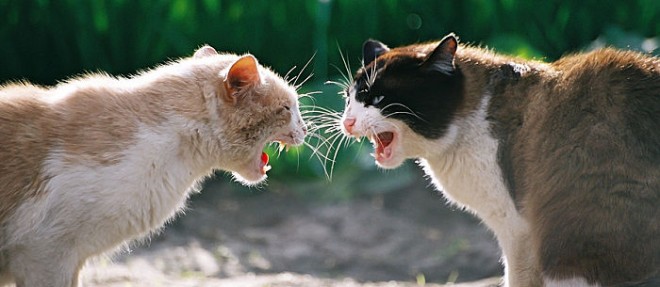
Us Canadians love our cats. Recent surveys have shown over 1/3 of Canadian households have one. Its easy to see why. Cats are wonderful companions – affectionate and playful. They are also intelligent, independent problem solvers. Owners of cats learn daily what mischief their felines get into (providing priceless content for social media and YouTube)!
So, if having one cat is great, having two cats must be even better, right?! Well… not always!
Cats living in the same household can be strongly bonded to one another. In these cases, cats demonstrate their good relationship by sleeping or resting near each other, grooming each other, and playing together.
In other cases, cats peacefully co-exist, but are more roommates than friends. These cats choose different areas of the house to sleep and rest and rarely interact with each other. This is perfectly normal behaviour, as cats naturally prefer independence.
We will discuss the third scenario today: cats in conflict. Conflicting cats show signs that may be subtle (like staring or blocking resources) or more obvious (like stalking, hissing, swatting, growling, or fighting).
So how can a cat owner help keep the peace in a household with combating cats?
1) Plentiful Resources
- The key to a happy, calm cat is having plentiful resources readily available. Cats need to feel that they have the essentials for survival at their disposal and don’t like to share.
- Important resources for cats are food, water, a clean litterbox, a hiding place, a perch, a window to look outside, a scratching post
- Ideally each cat should have their own space within a house where they can retreat to and access their resources
- It is best to feed cats apart from one another
- The rule of thumb for litterboxes is to have 1 more litterbox in the house than there are cats. The litterboxes should be scooped daily and have a full clean out weekly.
2) Controlled introductions
- When first introducing a new cat into a household with an existing cat, there is a lot of risk for conflict: the new cat is stressed about its new environment, and the existing cat has someone encroaching on its turf!
- Before allowing the cats to see each other or interact, isolate the new cat in a separate room (containing the aforementioned resources). This should be a room where the existing cat doesn’t spend a lot of time. Allow a week for the new cat to adjust to the new surroundings, keeping the door closed.
- Try to get each cat used to the other’s scent before allowing them to meet. It may help to swab their bedding periodically. Giving each cat something positive (like food) while they are within ‘smelling distance’ (i.e. either side of a closed door) can help them feel more positive about the new cat’s scent.
- When you are ready to allow the cats to meet, gradually open the door enough for them to see each other. Wait until they can calmly look at each other without hissing or growling before slowing opening the door more and ultimately allowing them to meet!
3) Feliway
- Cats communicate via pheromones – a type chemical cats can produce and detect from other cats. Some pheromones communicate feelings or alarm or danger, whereas others communicate safety and security.
- Feliway is a synthetic version of the pheromone mothers release to their kittens when nursing. This pheromone communicates that the environment is safe.
- Feliway is available in a spray or diffuser and can help stressed cats feel more relaxed.
- Using a diffuser in a household with duelling cats can assist the peace-making process!
- It is also helpful to use when introducing new cats.
4) Time apart
- Cats that previously seemed to get along can suddenly start to fight. This can be due to new stressors, changes in social maturity as they age, or changes in scent of cats (eg. If one cat rolled in something smelly, the other may not recognize the new scent as perceive a new cat has arrived!)
- Fighting can become very serious with attacks, including scratching and biting. This increases the stress level among both cats.
- This scenario may require a ‘time out’ where the cats are kept in separate areas and not able to see each other or interact.
- Follow the steps above after the cats have had a reasonable time to calm after a battle (this may be a few days to weeks)
5) Behavioural modifying medications
- In some cases, a cat will act aggressively despite their owners following all the advice above
- Inappropriate or unexplained aggression may indicate a behavioural disorder
- These cats may require a course of behaviour modifying medication to help control aggressive behaviour
- Please speak with your veterinarian about the diagnosis and management of behavioural disorders



